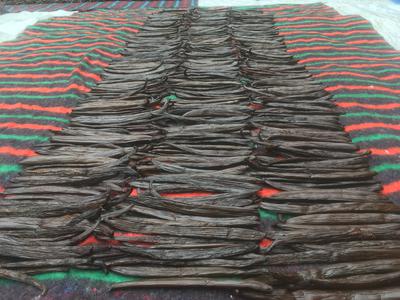VANILLA BEANS | SOYBEAN OIL | SOYMEAL & CAKE | COCOA BEANS | COFFEE BEANS
Bourbon Vanilla

Bourbon Vanilla Beans
Bourbon and vanilla
Bourbon Vanilla (V. planifolia Andrews): This is the terminology used collectively for beans from Madagascar, Réunion, the Comoro Islands and the Seychelles.
Bourbon vanilla is the name given to the product from the former French possessions in the Indian Ocean, which employ a curing technique first developed on the island of Reunion, formerly known as Bourbon. Production of Bourbon-type vanilla is now dominated by Madagascar, with the Comoro Islands and Reunion as smaller but important sources.
The Bourbon curing technique is distinguished from those of Mexico in that 'killing' is achieved by scalding the beans in hot water and fewer sweatings are undertaken. The Bourbon product usually has higher moisture content than the corresponding Mexican grade and is frequently frosted. As in Mexico, curing of vanilla is carried out by specialist firms rather than by the vanilla growers.
Slight variations in the curing technique are practiced in the various producing islands and the following is a description of the procedure evolved on Madagascar:
On arrival at the curing factory, the beans are sorted according to the degree of maturity, size, and into split and unsplit types. Batches of beans, weighing 25 to 30 kg, are loaded into openwork cylindrical baskets, which are then plunged into containers full of hot water heated to 63 to 65 °C over a wood fire. Batches of beans, which will eventually make up the top three qualities, are immersed for 2 to 3 minutes, while smaller and split beans are treated for less than 2 minutes.
The warm beans are rapidly drained, wrapped in a dark cotton cloth and are placed in a cloth-lined sweating box. After 24 hours, the beans are removed and inspected to separate those, which have not been properly killed.
The next stage of sun-drying is carried out on a plot of dry, easily drained ground, at some distance from roads to avoid contamination by dust. The killed beans are spread out on dark cloths resting on slatted platforms, constructed from bamboo and raised 70 cm above the ground. After one hour of direct exposure to the sun, the edges of the cloth are folded over the beans to retain the heat. The cloth-covered beans are then left for a further two hours in the sun before the blanket is rolled up and taken indoors. This procedure is repeated for 6 to 8 days until the beans become quite supple.
The third stage involves slow drying in the shade for a period of 2 to 3 months. The beans are spread on racks, mounted on Supports and are spaced 12 cm apart in a well-ventilated room. During this slow drying operation, the beans are sorted regularly and those which have dried to the requisite moisture content are immediately removed for conditioning.
In some localities in the Bourbon producing areas, where the weather is frequently inclement during the sun-and indoor-drying periods of curing, ovens set at 45 to 50 °C have traditionally been used.
Conditioning of the beans is carried out in a similar manner to that described for Mexico and takes about 3 months for completion. The overall curing process for Bourbon vanilla lasts for 5 to 8 months. The main harvesting season in Madagascar extends from June to early October.
A modification to the traditional Bourbon curing method was devised in Puerto Rico in the 1940s and was adopted by the vanilla co-operative at Castaner. On arrival at the factory, the beans are sorted into split and unsplit types and are then killed as soon as possible.
Prior to killing, the beans are wiped with a damp cloth. Scalding entails three 10-second immersions at 30-second intervals in a water bath at 80 °C. After draining, the beans are wrapped in a blanket and are placed in a sweating box. Killing is followed by daily two-hour sunnings and overnight sweatings for about seven days until the beans become supple.
The next stage of indoor air-drying is continued until the beans reach one-third of their original weight. The beans are then bundled and conditioned in tin boxes until they dry to one-quarter of their original weight.
By contrast to Bourbon vanilla from the Indian Ocean producers, Puerto Rican vanilla scalded at 80 °C rarely frosts.
When the weather is unsuitable for sunning, the beans are sweated in a closed oven at 45 °C containing a pan of water.
If you haven't yet found what you were looking for or you need detailed information about the subject matter on this page then... feel free to ask our business travel consultants. |




